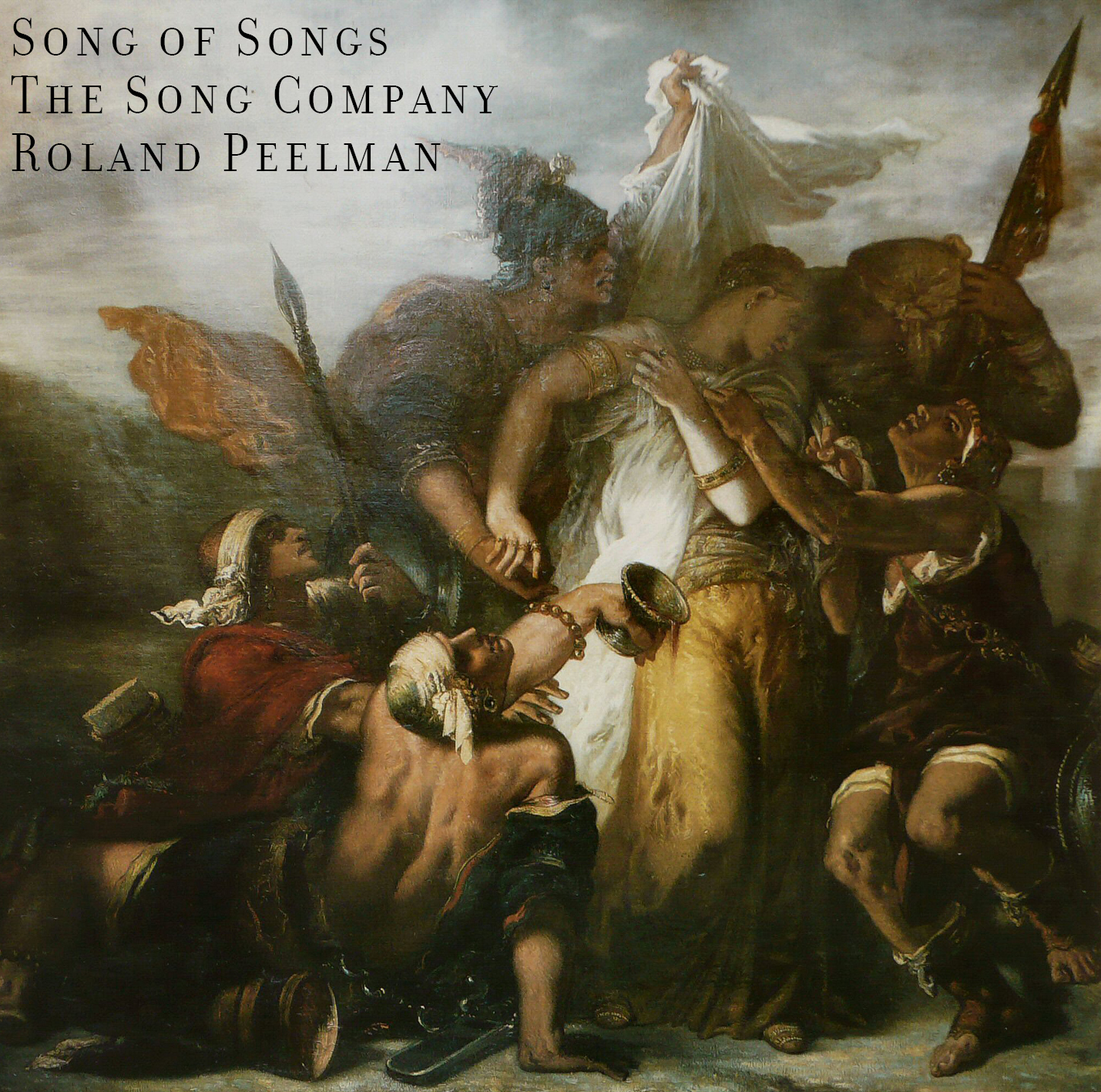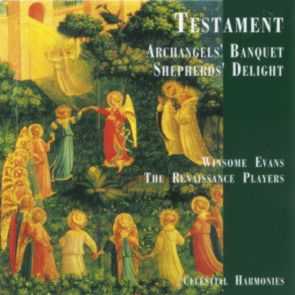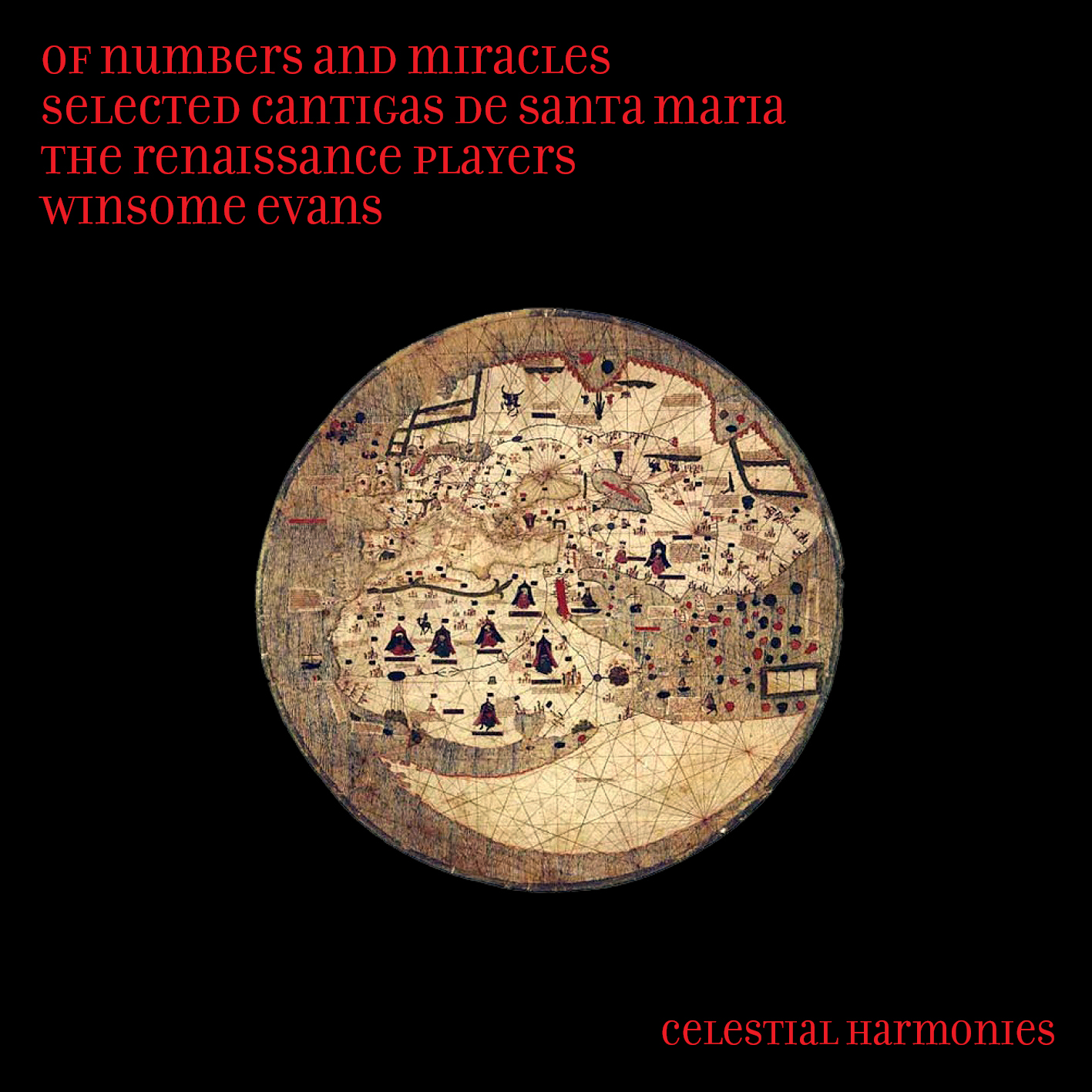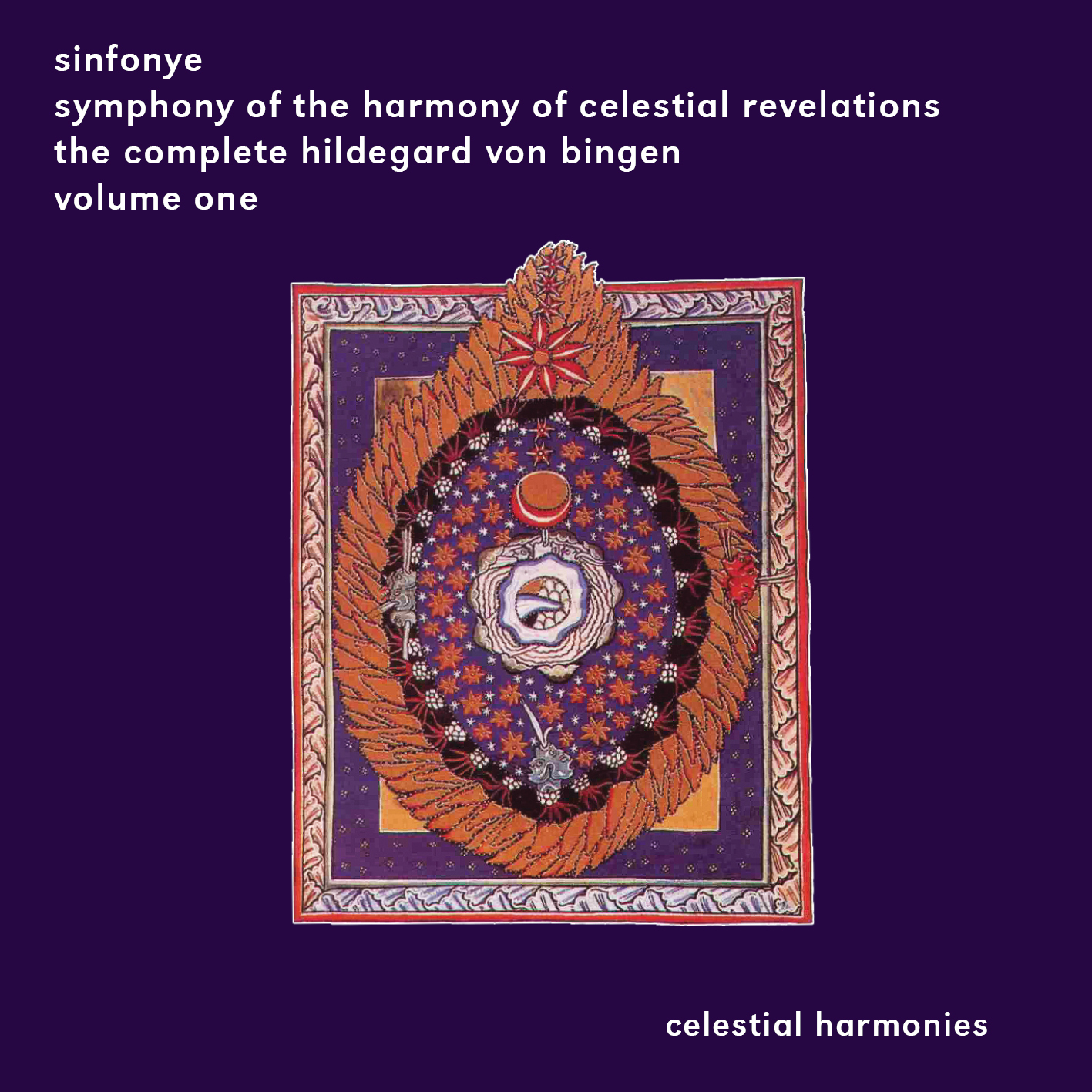early music news (australia)
October/November 2002

 13199 SONG
OF SONGS - THE SONG COMPANY, ROLAND PEELMAN - DIRECTOR
(.pdf)
13199 SONG
OF SONGS - THE SONG COMPANY, ROLAND PEELMAN - DIRECTOR
(.pdf)
Not much needs to be said. Simply, this CD is pretty darn good: it
is highly polished as regards the singing, acoustics, recording and
presentation. Motet settings from the 15th to mid 17th century by Palestrina,
Monteverdi, Gaspar van Weerbeke, Franck, Luis de Victoria, de Silva,
de Lymburgia and Verdelot are set to texts from the biblical love-poems,
The Song of Songs. The pace across the compass of the 22 tracks could
be thought to be a trifle uniform but for the abandon of immersing oneself
in luxurious motet sound, this is the perfect CD.
December/January 2001

 14197 TESTAMENT:
ARCHANGELS' BANQUET / SHEPHERDS' DELIGHT (2 CD) - WINSOME EVANS AND
THE RENAISSANCE PLAYERS
14197 TESTAMENT:
ARCHANGELS' BANQUET / SHEPHERDS' DELIGHT (2 CD) - WINSOME EVANS AND
THE RENAISSANCE PLAYERS
This two–disc set sits well with one's RP disc collection after
the four Sephardic Experience series, both because it is (mostly) a
change of colour, and also as it records most of the more recent RP
line up. As usual, director Winsome Evans has gone to great lengths
to explain the album concept, and to provide extensive notes on both
the material and the how and why of the arrangements. (And as least
this time it is possible to get the @=#$%& booklet back in the case!)
Folk tunes from England, Ireland, the Basque region, Greece, the USA
and Spain feature, alongside anonymous medieval works and compositions
by Morley, Facoli, Bull and others. Much of Testament has a Celtic flavour
ranging from rapturously Vaughan Williams–ish harmonies to pieces
strongly reminiscent of groups such as the Chieftains. The Celtic mist
is cleared in opportune places by distinctly Italian, German, Mediterranean
and black American pieces. (The two American tracks, Ching–A–Ring
and Virgin Mary, Meek and Mild, are tremendous fun and a great
illustration of what a wonderful ragtime instrument a harpsichord can
be!) There is also a good variety in the "size" of the pieces,
which range from solo flute through duets and trios right up to "big
band" sounds that use the whole range of tone colours at the RPs
disposal.
The arrangements are imaginative, even in the simplest pieces. Particularly
noteworthy is the skillful arranging for equal voices, and the way that
so many instruments can add to the "textural" sound without
getting in each other's way.
Sally Treloyn's flute playing is worthy of particular mention in this
context. She uses a modern instrument, but plays with a dark sound reminiscent
of folk wooden flute players such as The Chieftains' Matt Molloy. This
tone and her fluency make the modern instrument fit well into an ensemble
of otherwise mostly period instruments. The singing is pleasant and
free, communicating a joy in singing rather than pedantic (and in this
sort of music, boring) "classical" technical perfection. This
is not to say the singing is technically below par, it is just nice
to hear singers singing rather than hear a display of their technique.
Percussion from both Andrew Lambkin and the (sadly) late Barbara Stackpool
is, as always, excellent, providing both a rock solid foundation for
the rest of the ensemble and embellishment to the music. The collection
is nicely recorded, each instrument and voice sounding immediate yet
with plenty of bloom from the acoustic.
There are quite a few original compositions in the collection, and
many tracks have been, to quote the programme notes, "extensively
arranged". Some of the folk tunes date from after the EMA's current
period of interest. Whether or not some of it is "early music"
could be the stuff of first class tavern brawls, which in my experience
usually produce only a zero increase in the body of human wisdom, and
lots of broken furniture. Testament should be approached as one would
an RP Christmas Pudding concert—there is "early music"
aplenty but the players don't let deadlines or boundaries stop them
"letting their hair down" with anything at all that works
with their line–up.
A thumping good recording. Buy one.
June/July 2001

 13091 OF
NUMBERS AND MIRACLES: SELECTED CANTIGAS DE SANTA MARIA - WINSOME
EVANS AND THE RENAISSANCE PLAYERS
13091 OF
NUMBERS AND MIRACLES: SELECTED CANTIGAS DE SANTA MARIA - WINSOME
EVANS AND THE RENAISSANCE PLAYERS
The latest Renaissance Players collection of Cantigas de Santa Maria
is dedicated to the memories of patron and mentor, Prof Peter Platt,
and long time Players percussionist, Barbara Stackpool. The 14 tracks
are a compilation of cantigas already released on the disks, Songs
for a Wise King, Maria Morning Star, and Mirror of Light. Should you
already be in possession of these fine CDs, you might not feel up
to the duplication, but if you are not already thus far convinced,
this release provides an excellent sampling.
Thumping, classic RP sound and strong characteristic vocals are represented
in Santa Maria strella do dia—one of the group's all–time
greats. Character is as tightly compressed as a bale of peat moss
in Mara Kiek's rendition of Rosa das rosas, but for soothing
contrast, the gentle, Assi pod'a Virgen, and lyrical, Muito
devemos varoes, are appreciable inclusions. The sinfonye and dronish
harmonies are rendered by Mina Kanaridis and Jennny Duck-Chong, make
Oque pola Virgin leixa yet another unforgettable classic.
Bombarde times three (overlaid, but where in heck would you ever
find three compatible bombardes without bomb–throwing players)
in A madre do que a bestia, is a feisty discovery.
Today's rendition of the Cantigas de Santa Maria might only be suggestions
from the ancient manuscripts of Alfonso X, but Winsome Evan's arrangements,
that she, herself, describes as "musicologicallly plausible"
are the best we're going to get this side of reincarnation.
August/September 1996

 13127 SYMPHONY
OF THE HARMONY OF CELESTIAL REVELATIONS: THE COMPLETE HILDEGARD VON
BINGEN, VOLUME ONE - SINFONYE
13127 SYMPHONY
OF THE HARMONY OF CELESTIAL REVELATIONS: THE COMPLETE HILDEGARD VON
BINGEN, VOLUME ONE - SINFONYE
This disc of responsories and antiphons (many to St.
Ursula), and a hymn to the Holy Spirit, is one that rewards repeated,
careful listening. The recording differs greatly from the famous "A
Feather on the Breath of God", with which it will inevitably
be compared, but it is complimentary and I think, equally beautiful.
The Gothic Voices disc has an exhilarating loveliness based on individual
interpretations of Hildegard's music. Wishart gives us a collective
approach—what might have been experienced in Hildegard's own
choir, perhaps, with like–minded but very real flesh–and–blood
women. To this end, Wishart has employed rote/aural learning techniques,
and a great deal of "collective experience" in rehearsal.
The result is very "unconducted", not because
of any untidiness (ensemble is an excellent throughout), but because
of the combined senses of freedom and unity. The expressiveness seems
born of a commonly arrived–at understanding, an approach that
serves Hildegard well—her works have a personal intensity that
perhaps should be expected from a mystic of ecstatic visions.
Variety of sound is achieved by sensitive use of hurdy–gurdy
drones and improvisations, short "bursts" of organum (parallel
and more free), and in one track, an exquisite, hummed "drone"
at a higher pitch than the melody. Less obvious at first, but clearer
with every listening, is the careful use of vocal colour, which extends
to a willingness to push voices to heights that would be unpretty
in any other kind of music, but here simply reinforce the earthy quality
of the recording. (Those that enjoy Winsome Evans' work will find
the West, Ellis and Wishart trio in the final track reminiscent of
the gutsy, soaring singing of Duck–Chong, Kanaridis and Montgomery
with the Renaissance Players.) There are voices in the "Gothic
Voices" mould, a delightfully lightweight, reedy alto reminiscent
of former Sinfonye–an, Mara Kiek, and voices of the more rough
and ready type. One such, Julie Murphy, was known to me only from
Saydisc's Songs of Thomas Hardy's Wessex, with that rather
unemotional folk style that scorns much of "good technique".
Her work here represents one aim of the recording—a beautiful
performance, but one that sounds like a "real" woman.
Three cheers for the Oxford Girls' Choir (including an
outstanding soloist) who appear in three tracks. In these "enlightened"
times when sound qualities once derided are accepted as simply different,
we still persist with the view that boys' voices are "better",
and girl's voices "inferior". The OGC sings with that little
bit of flair that is crucial to what Wishart sets out to achieve.
They also have a focus, a slight "edge" or reediness, that
boys (to my ear) rarely have, and the hooty–flooty uniformity
appropriate to many works written for boys would not express the ecstatic,
passionate serenity found in these works by Wishart et al. One case
where I believe "different" is "better".
The good news is—this is but Volume One.
|



